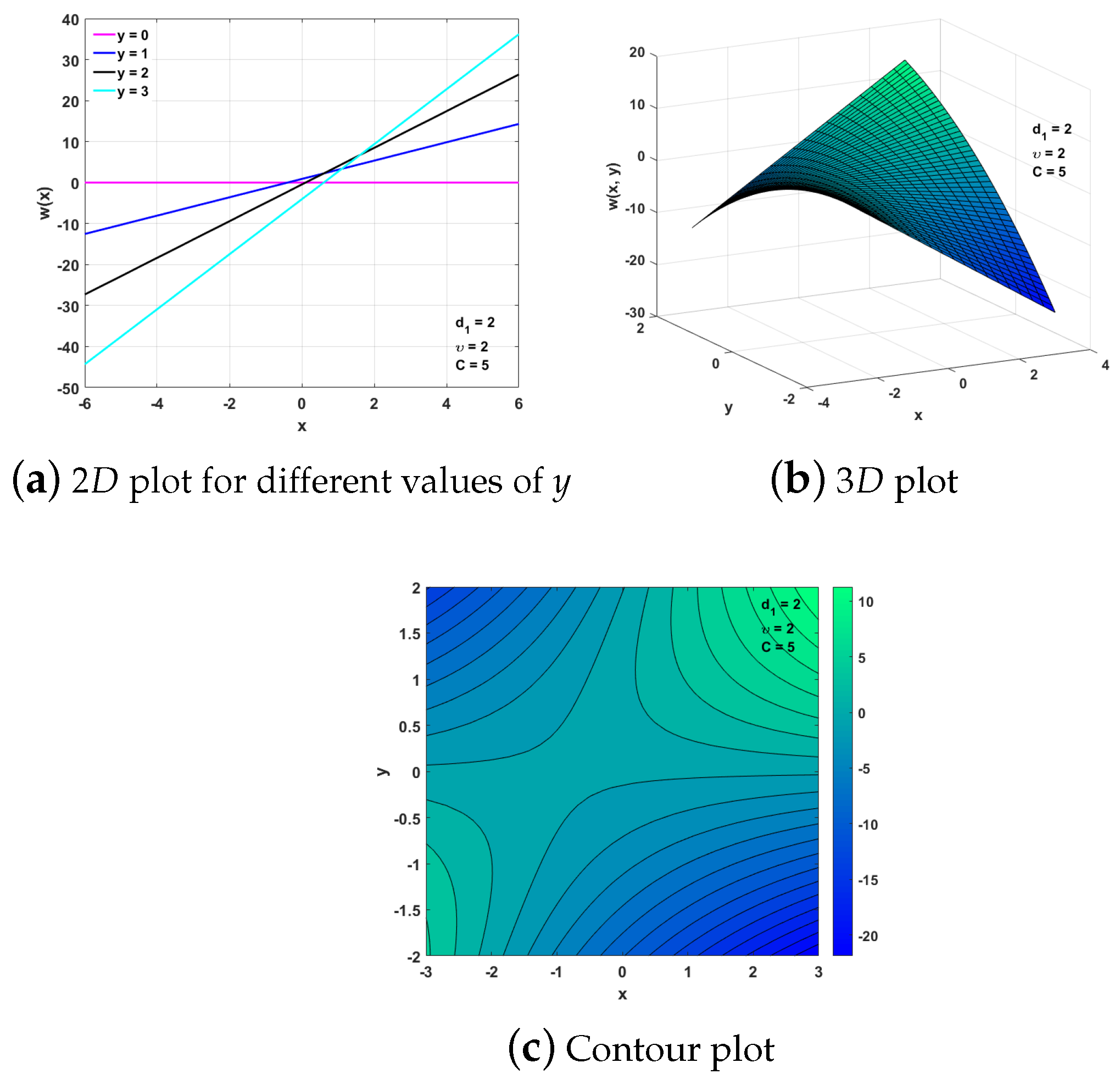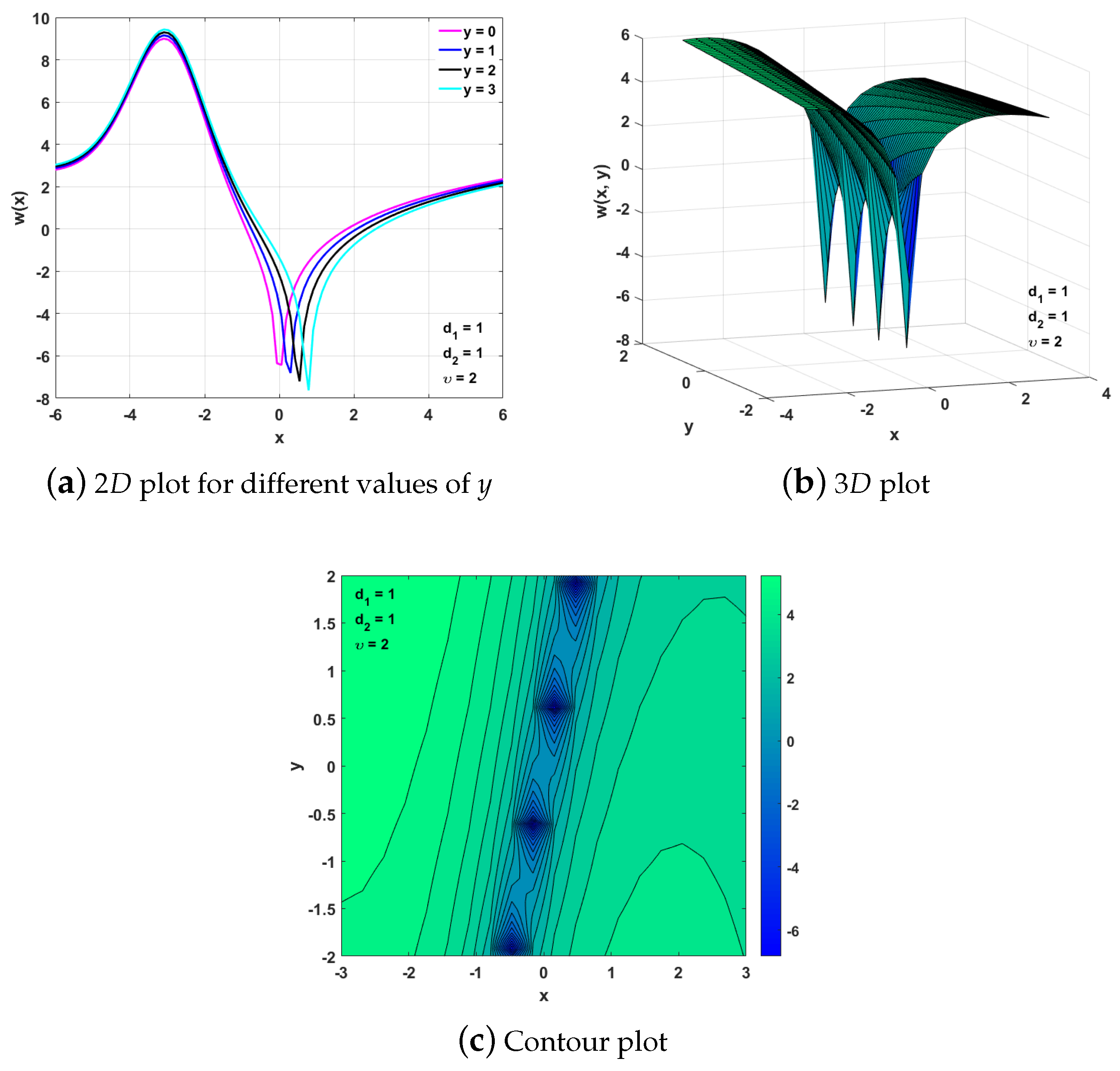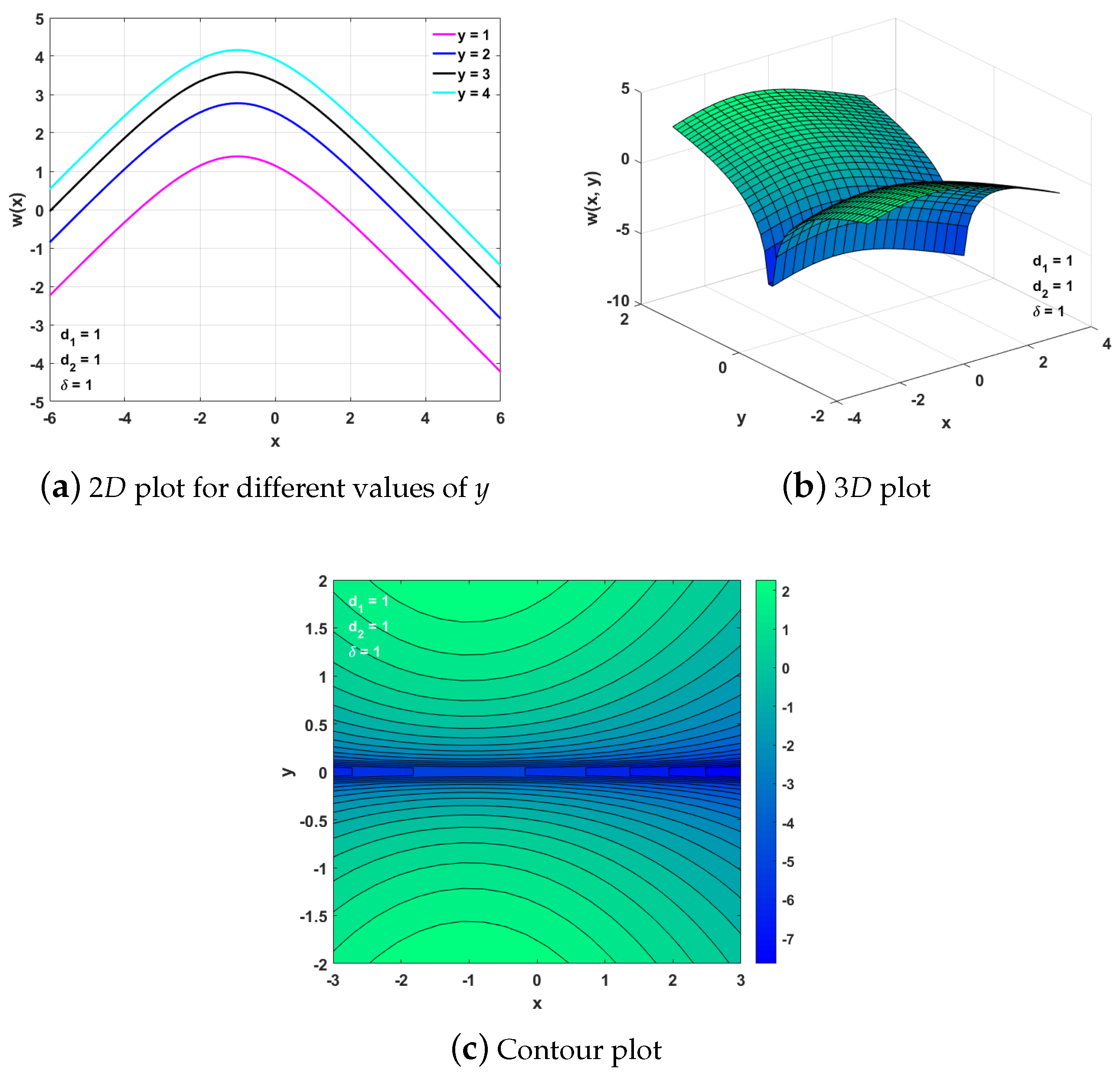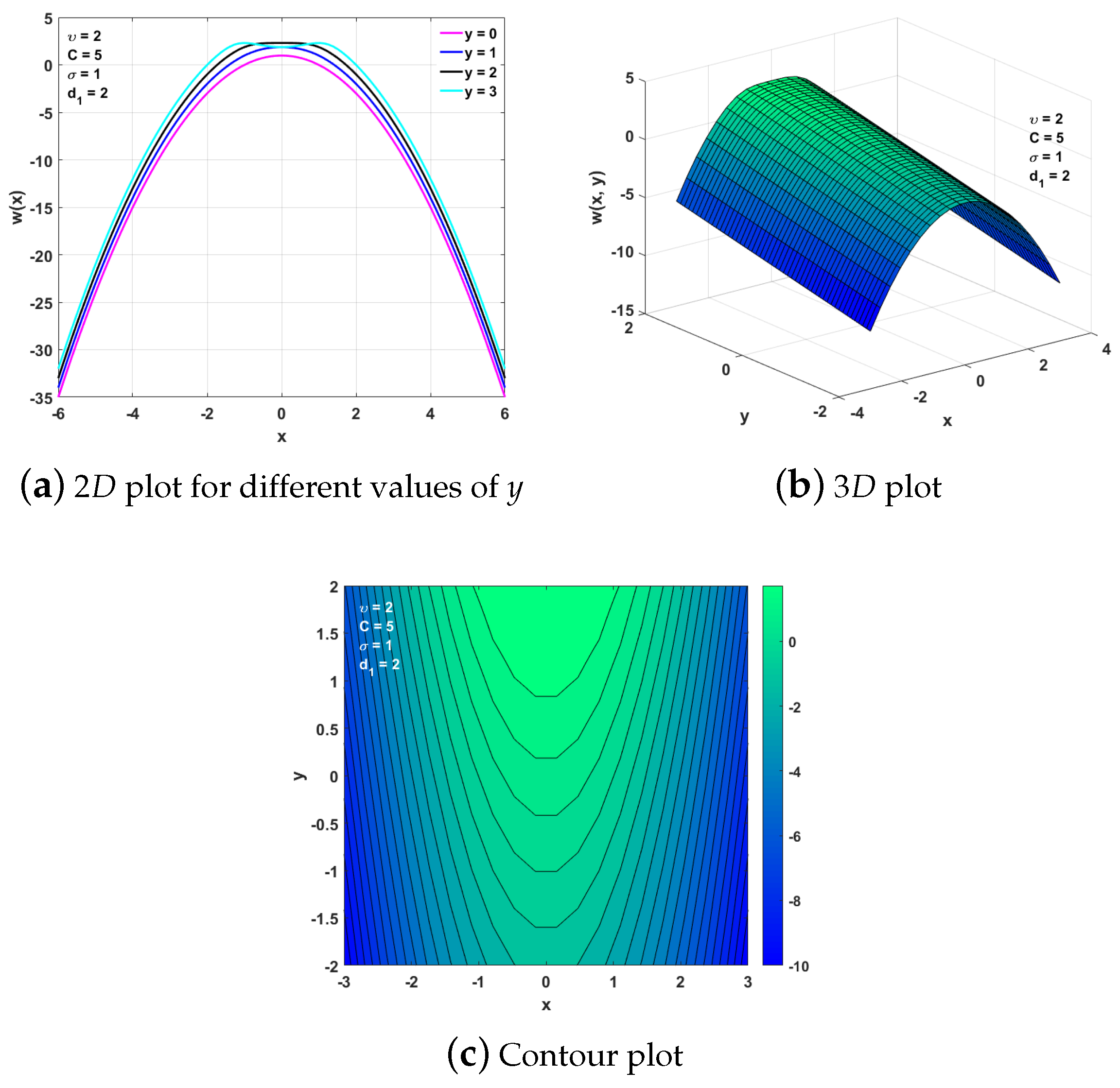Lie Group Classification, Symmetry Reductions, and Conservation Laws of a Monge–Ampère Equation
Abstract
1. Introduction
2. Symmetry Group Classification
- Case 1:
- Case 2:
- Subcase 2.1:
- Subcase 2.1.1: and
- Subcase 2.1.2: and
- Subcase 2.2:
3. Optimal System of One-Dimensional Subalgebras
3.1. Commutator Table and Adjoint Representation
3.2. Optimal System of One-Dimensional Subalgebras
- Case 1:
- Case 2:
4. Reductions to Ordinary Differential Equations and Invariant Solutions
4.1. Reductions for Arbitrary Function
4.2. Reductions for Case 1
4.3. Reductions for Case 2.1.1
4.4. Reductions for Case 2.1.2
4.5. Reductions for Case 2.2
5. Conservation Laws
- Determining the Lagrangian of the system;
- Implementing the Noether’s theorem.
- Case 1: is an arbitrary function of w
- Case 2: is not an arbitrary function of w
- Subcase 2.1: and
- Subcase 2.2:
- Subcase 2.2.1:
- Subcase 2.2.2:
- Following Noether’s theorem, which says there is a one-to-one correspondence between symmetries and conservation laws of a variational system, one can construct higher-order symmetries using these conservation laws, which may aid in identifying new exact solutions or soliton solutions.
- Moreover, in some cases, they can be reduced to first-order forms, indicating some fundamental physical principles.
- In the domains of fluid dynamics and nonlinear wave equations, such conservation laws are often linked to soliton-like behavior, revealing the broader physical applications. While first-order conservation laws are only related to fundamental physical principles, higher-order ones may describe more complex conserved quantities, such as higher-order stress tensors or non-local effects.
- In numerical schemes, these conservation laws are useful in the development of structure-preserving algorithms for solving differential equations that ensure numerical accuracy and stability in computational models.
6. Conclusions
- Derivation of non-classical symmetries, generalizations of this equation in higher dimensions, and the exploration of higher-order symmetries.
- Applying Lie symmetry methods to study more nonlinear models appearing in fields such as geometric optics, fluid dynamics, and machine learning.
- Reductions of higher-order conservation laws into the first order.
Author Contributions
Funding
Data Availability Statement
Conflicts of Interest
References
- Villani, C. Optimal Transport: Old and New; Springer: Berlin, Germany, 2009; Volume 338. [Google Scholar]
- Renardy, M.; Rogers, R.C. An Introduction to Partial Differential Equations; Springer Science & Business Media: Berlin/Heidelberg, Germany, 2006; Volume 13. [Google Scholar]
- Udrişte, C.; Bîlă, N. Symmetry Lie group of the Monge-Ampère equation. Appl. Sci. 1999, 1, 121–136. [Google Scholar]
- Trudinger, N.S.; Wang, X.-J. The Monge-Ampère equation and its geometric applications. Handb. Geom. Anal. 2008, 1, 467–524. [Google Scholar]
- Ovsiannikov, L.V. Group Analysis of Differential Equations; Academic Press: New York, NY, USA, 1982; Volume 1. [Google Scholar]
- Arif, F.; Jhangeer, A.; Mahomed, F.M.; Zaman, F.D. Lie group classification and conservation laws of a (2 + 1)-dimensional nonlinear damped Klein–Gordon Fock equation. Partial. Differ. Equ. Appl. Math. 2024, 12, 100962. [Google Scholar] [CrossRef]
- Bluman, G.W.; Kumei, S. Symmetries and Differential Equations; Springer Science & Business Media: Berlin/Heidelberg, Germany, 2013; Volume 81. [Google Scholar]
- Olver, P.J. Applications of Lie Groups to Differential Equations; Springer Science & Business Media: Berlin/Heidelberg, Germany, 1993; Volume 107. [Google Scholar]
- Ibragimov, N.H. CRC Handbook of Lie Group Analysis of Differential Equations; CRC Press: Boca Raton, FL, USA, 1994–1996; Volumes 1–3. [Google Scholar]
- Polyanin, A.D.; Aksenov, A.V. Unsteady Magnetohydrodynamics PDE of Monge–Ampère Type: Symmetries, Closed-Form Solutions, and Reductions. Mathematics 2024, 12, 2127. [Google Scholar] [CrossRef]
- An, N.; Bao, J.; Liu, Z. Entire solutions to the parabolic Monge–Ampère equation with unbounded nonlinear growth in time. Nonlinear Anal. 2024, 239, 113441. [Google Scholar] [CrossRef]
- Gao, F. Hyperbolic Monge-Ampère Equation. J. Appl. Math. Phys. 2020, 8, 2971–2980. [Google Scholar] [CrossRef]
- Ma, Y.; Song, Y.; Yang, B.; Wang, Z. Lie symmetry analysis, exact solutions and power series solutions of the logarithmic Monge–Ampère flow evolution equation. Int. J. Geom. Methods Mod. Phys. 2022, 19, 2250209. [Google Scholar] [CrossRef]
- Alekseevsky, D.; Manno, G.; Moreno, G. Invariant Monge-Ampere equations on contactified para-Kahler manifolds. arXiv 2024, arXiv:2402.08315. [Google Scholar]
- Figalli, A. The Monge-Ampère Equation and Its Applications; European Mathematical Society: Helsinki, Finland, 2017. [Google Scholar]
- Gilbarg, D.; Trudinger, N.S. Elliptic Partial Differential Equations of Second Order; Springer: Berlin/Heidelberg, Germany; New York, NY, USA, 1977. [Google Scholar]
- Ibragimov, N.H. A new conservation theorem. J. Math. Anal. Appl. 2007, 333.1, 311–328. [Google Scholar] [CrossRef]
- Villani, C. Topics in Optimal Transportation; American Mathematical Society: Providence, RI, USA, 2021; Volume 58. [Google Scholar]
- Zilbergleit, L. Second-order differential equation associated with contact geometry: Symmetries, conservation laws and shock waves. Acta Appl. Math. 1996, 45, 51–71. [Google Scholar] [CrossRef]
- McMillan, B.B. Geometry and Conservation Laws for a Class of Second-Order Parabolic Equations II: Conservation Laws. Symmetry Integr. Geom. Methods Appl. 2021, 17, 047. [Google Scholar] [CrossRef]
- Rosenhaus, V.; Katzin, G.H. On symmetries, conservation laws, and variational problems for partial differential equations. J. Math. Phys. 1994, 35.4, 1998–2012. [Google Scholar] [CrossRef]
- Noether, A.E. Invariante variations probleme. Nachr. Akad. Wiss. Göttingen Math. Phys. KI. II. 1918, 235–237. [Google Scholar]
- Kara, A.H.; Mahomed, F.M. Noether-type symmetries and conservation laws via partial Lagrangians. Nonlinear Dyn. 2006, 45, 367–383. [Google Scholar] [CrossRef]
- Anco, S.C.; Bluman, G. Direct construction method for conservation laws of partial differential equations—Part I: Examples of conservation law classifications. Eur. J. Appl. Math. 2002, 13.5, 545–566. [Google Scholar] [CrossRef]
- Lychagin, V.V.; Rubtsov, V.N.; Chekalov, I.V. A classification of Monge-Ampere equations. Ann. Sci. L’école Norm. Supérieure 1993, 26. [Google Scholar] [CrossRef]
- Kruglikov, B. Classification of Monge-Ampère equations with two variables. Banach Cent. Publ. 1999, 50, 179–194. [Google Scholar] [CrossRef]
- Ibragimov, N.H. Nonlinear self-adjointness and conservation laws. J. Phys. A Math. Theor. 2011, 44, 432002. [Google Scholar] [CrossRef]
- Khabirov, S.V. Nonisentropic one-dimensional gas motions constructed by means of the contact group of the non-homogeneous Monge-Ampère equation. Math. USSR Sbornik 1992, 71, 447. [Google Scholar] [CrossRef]
- Meleshko, S.V. Methods for Constructing Exact Solutions of Partial Differential Equations: Mathematical and Analytical Techniques with Applications to Engineering; Springer: Berlin/Heidelberg, Germany, 2005. [Google Scholar]






| , | |||||
|---|---|---|---|---|---|
| 0 | 0 | 0 | |||
| 0 | 0 | 0 | |||
| 0 | 0 | ||||
| 0 | 0 | ||||
| 0 |
| , | |||||||||
|---|---|---|---|---|---|---|---|---|---|
| 0 | 0 | 0 | 0 | 0 | 0 | 0 | |||
| 0 | 0 | 0 | 0 | 0 | 0 | ||||
| 0 | 0 | 0 | 0 | 0 | |||||
| 0 | 0 | 0 | 0 | 0 | |||||
| 0 | 0 | 0 | 0 | 0 | |||||
| 0 | 0 | 0 | 0 | 0 | 0 | ||||
| 0 | 0 | 0 | 0 | 0 | 0 | 0 | 0 | 0 | |
| 0 | 0 | 0 | 0 | 0 | 0 | 0 | 0 | 0 | |
| 0 | 0 | 0 | 0 | 0 | 0 | 0 | 0 | 0 |
| , | ||||||
|---|---|---|---|---|---|---|
| 0 | 0 | 0 | 0 | |||
| 0 | 0 | 0 | ||||
| 0 | 0 | |||||
| 0 | 0 | |||||
| 0 | 0 | |||||
| 0 | 0 | 0 |
Disclaimer/Publisher’s Note: The statements, opinions and data contained in all publications are solely those of the individual author(s) and contributor(s) and not of MDPI and/or the editor(s). MDPI and/or the editor(s) disclaim responsibility for any injury to people or property resulting from any ideas, methods, instructions or products referred to in the content. |
© 2025 by the authors. Licensee MDPI, Basel, Switzerland. This article is an open access article distributed under the terms and conditions of the Creative Commons Attribution (CC BY) license (https://creativecommons.org/licenses/by/4.0/).
Share and Cite
Samina, S.; Arif, F.; Jhangeer, A.; Wali, S. Lie Group Classification, Symmetry Reductions, and Conservation Laws of a Monge–Ampère Equation. Symmetry 2025, 17, 355. https://doi.org/10.3390/sym17030355
Samina S, Arif F, Jhangeer A, Wali S. Lie Group Classification, Symmetry Reductions, and Conservation Laws of a Monge–Ampère Equation. Symmetry. 2025; 17(3):355. https://doi.org/10.3390/sym17030355
Chicago/Turabian StyleSamina, Samina, Faiza Arif, Adil Jhangeer, and Samad Wali. 2025. "Lie Group Classification, Symmetry Reductions, and Conservation Laws of a Monge–Ampère Equation" Symmetry 17, no. 3: 355. https://doi.org/10.3390/sym17030355
APA StyleSamina, S., Arif, F., Jhangeer, A., & Wali, S. (2025). Lie Group Classification, Symmetry Reductions, and Conservation Laws of a Monge–Ampère Equation. Symmetry, 17(3), 355. https://doi.org/10.3390/sym17030355





